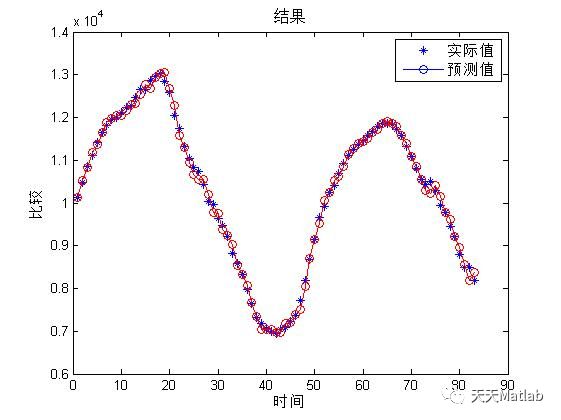基于萤火虫算法优化的BP神经网络预测模型附Matlab代码
✅作者简介:热爱科研的Matlab仿真开发者,修心和技术同步精进,matlab项目合作可私信。
个人主页:Matlab科研工作室
个人信条:格物致知。
更多Matlab仿真内容点击
智能优化算法 神经网络预测 雷达通信 无线传感器
信号处理 图像处理 路径规划 元胞自动机 无人机
⛄ 内容介绍
BP(Back Propagation)神经网络是目前最重要的神经网络之一,其结构简单、工作时状态稳定、并且易于硬件实现,被广泛应用于模式识别、分类预测、系统仿真和图像处理等诸多领域。但是,BP神经网络在广泛应用过程中被发现存在一些缺陷,比如对初始权值敏感、容易陷入局部极小值、隐含层结构难以确定等。针对这些问题,本文提出一种利用萤火虫群优化算法训练BP神经网络的权值和阈值的方法。萤火虫群优化算法是一种基于群体智能的优化算法,能较快地找到全局最优值。利用萤火虫群优化算法结合BP算法获得较好的网络初始连接权值和阈值,以此开始网络的学习,通过仿真实验表明,该优化算法在分类预测问题中有较高的测试精度和较好的拟合能力,避免了BP神经网络对初始值敏感和训练过程容易陷入局部极小值的问题,提高了BP神经网络的泛化能力、收敛速度和学习能力,验证了该优化算法的可行性和有效性。
⛄ 部分代码
%% Cost or Objective function
function [nbest,fbest,NumEval]=ffa_mincon(u0,Lb,Ub,para,inputnum,hiddennum,outputnum,net,inputn,outputn) % para=[20 500 0.5 0.2 1];
% Check input parameters (otherwise set as default values)
if nargin<5, para=[20 50 0.25 0.20 1]; end
if nargin<4, Ub=[]; end
if nargin<3, Lb=[]; end
if nargin<2,
disp('Usuage: FA_mincon(@cost,u0,Lb,Ub,para)');
end
% n=number of fireflies
% MaxGeneration=number of pseudo time steps
% ------------------------------------------------
% alpha=0.25; % Randomness 0--1 (highly random)
% betamn=0.20; % minimum value of beta
% gamma=1; % Absorption coefficient
% ------------------------------------------------
n=para(1);
MaxGeneration=para(2); %MaxGeneration
alpha=para(3);
betamin=para(4);
gamma=para(5);
NumEval=n*MaxGeneration;
% Check if the upper bound & lower bound are the same size
if length(Lb) ~=length(Ub),
disp('Simple bounds/limits are improper!');
return
end
% Calcualte dimension
d=length(u0); %
% Initial values of an array
zn=ones(n,1)*10^100;
% ------------------------------------------------
% generating the initial locations of n fireflies
[ns,Lightn]=init_ffa(n,d,Lb,Ub,u0); %
% Iterations or pseudo time marching
for k=1:MaxGeneration, %%%%% start iterations
% This line of reducing alpha is optional
alpha=alpha_new(alpha,MaxGeneration);
% Evaluate new solutions (for all n fireflies)
for i=1:n,
zn(i)=fun(ns(i,:),inputnum,hiddennum,outputnum,net,inputn,outputn);
Lightn(i)=zn(i);
end
% Display the shape of the objective function
% Ranking fireflies by their light intensity/objectives
[Lightn,Index]=sort(zn);
ns_tmp=ns;
for i=1:n,
ns(i,:)=ns_tmp(Index(i),:);
end
%% Find the current best
nso=ns;
Lighto=Lightn;
nbest=ns(1,:);
Lightbest=Lightn(1);
% For output only
fbest=Lightbest;
% Move all fireflies to the better locations
[ns]=ffa_move(n,d,ns,Lightn,nso,Lighto,nbest,Lightbest,alpha,betamin,gamma,Lb,Ub);
end %%%%% end of iterations
% The initial locations of n fireflies
function [ns,Lightn]=init_ffa(n,d,Lb,Ub,u0)
% if there are bounds/limits,
if length(Lb)>0,
for i=1:n,
ns(i,:)=Lb+(Ub-Lb).*rand(1,d);
end
else
% generate solutions around the random guess
for i=1:n,
ns(i,:)=u0+randn(1,d);
end
end
% initial value before function evaluations
Lightn=ones(n,1)*10^100;
% Move all fireflies toward brighter ones
function [ns]=ffa_move(n,d,ns,Lightn,nso,Lighto,nbest,Lightbest,alpha,betamin,gamma,Lb,Ub)
% Scaling of the system
scale=abs(Ub-Lb);
% Updating fireflies
for i=1:n
% The attractiveness parameter beta=exp(-gamma*r)
for j=1:n,
r=sqrt(sum((ns(i,:)-ns(j,:)).^2)); %
% Update moves
if Lightn(i)>Lighto(j), % Brighter and more attractive
beta0=1; beta=(beta0-betamin)*exp(-gamma*r.^2)+betamin;
tmpf=alpha.*(rand(1,d)-0.5).*scale;
ns(i,:)=ns(i,:).*(1-beta)+nso(j,:).*beta+tmpf;
[ns]=findlimits(n,ns,Lb,Ub);
end
end % end for j
end % end for i
% convergence can occur. So use with care.
function alpha=alpha_new(alpha,NGen) %
% alpha_n=alpha_0(1-delta)^NGen=0.005
% alpha_0=0.9
delta=1-(10^(-4)/0.9)^(1/NGen);
alpha=(1-delta)*alpha;
function [ns]=findlimits(n,ns,Lb,Ub)
for i=1:n,
% Apply the lower bound
ns_tmp=ns(i,:);
I=ns_tmp ns_tmp(I)=Lb(I); % Apply the upper bounds J=ns_tmp>Ub; ns_tmp(J)=Ub(J); % Update this new move ns(i,:)=ns_tmp; end [1]张小琼. 基于改进萤火虫群优化算法的BP神经网络研究[D]. 广西大学, 2016. ❤️ 关注我领取海量matlab电子书和数学建模资料 ❤️部分理论引用网络文献,若有侵权联系博主删除 ⛄ 运行结果
⛄ 参考文献
